October 25th, 2013 ~ by admin
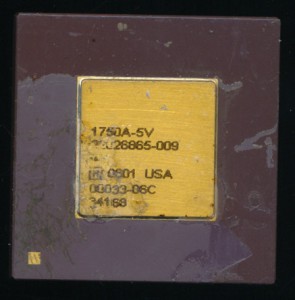
Honeywell 1750A-5V -2008
While its not in the best condition I was still pleased when it came in. MIL-STD-1750A was first developed in 1980 to provide a uniform architecture for military computing, while allowing competition in the market to produce different versions at a hoped for reduced cost. By 1996 though the 1750A was declared inactive for new designs in the US military. It had been widely replaced by other more powerful commercial designs, notably the 80386 and 80486. Many militaries around the world continue to use the 1750A and the US Military continues to need spares.
Honeywell continues to produce the 1750A-5V, a single chip implementation of the 1750A with on-board 40-bit FPU, much like Fairchild’s commercial F9450. Produced on a CMOS SOI (SIlicon On Insulator) 0.65u process the 1750A-5V runs at up to 40MHz, twice as fast as most did in the 1980’s. This particular example was produced in 2008 though Honeywell continues to make and advertise the 1750A.
The radiation hardened version was used on the Cassini Orbiter (now orbiting Saturn), ESA’s Rosetta Comet probe as well as the Guidance computer for the Air Force’s Titan 4 missile.
October 8th, 2013 ~ by admin
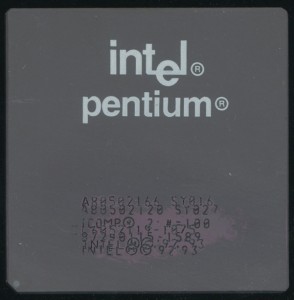
Pentium 166 SY016 Faked from Mobile 120 SY027
Here is an interesting example of what led Intel (and other manufacturers) to start locking down multipliers on their processors as well as adding anti-counterfeiting measures. This processor appears to be a 166MHz Pentium Processor, which in 1997 sold for around $200. A 120MHz Mobile Pentium sold for less than $100. Thus processors of lower speeds were often remarked by unscrupulous dealers and sold as higher speed parts. The forgeries had to be made quick, as processor prices dropped very quickly, the 166MHz Pentium debuted at nearly $1000. Most Pentium fakes were made by painting over the original markings and painting/engraving news ones. Some of the better fakes ground down the old markings first. Nearly all are easy to spot by the trained eye, wrong fonts, date mismatches, etc.
This particular example, from somewhere in 1997, was faked from a Pentium 120MHz mobile to a 166MHz desktop Pentium. As far as fakes go this was a fairly conservative one. Often 166s were faked from 100s or even 75s. The 120 was a 2x60MHz processor running at 3.1V, while the 166 is 2.5×66 (you see why locking the multiplier discouraged faking?) running at 3.3V. This resulted in a 28% overclock at about a 6% voltage increase. In this case the processor likely ran fairly well, if perhaps a bit warm. Some of the more extreme fakes resulted in very unstable systems due to overheating and pushing a processor well beyond what it was designed for.
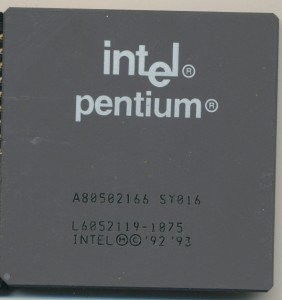
Before removing paint
Today counterfeit chips are still a major problem, though it was shifted from the consumer market, where prices are generally low, to the military and industrial market, where prices are high, and there is still demand for older devices.
October 6th, 2013 ~ by admin
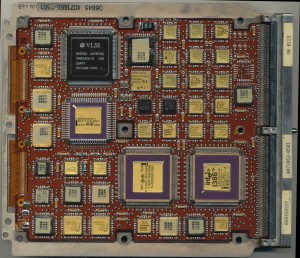
Raytheon KGV-25 – Click to Enlarge
Sometimes we get processors in on boards that are just too interesting, or too good looking to remove. That is the case with this KGV-25 correlator board. It is a processing systems used for decrypting communications that was in wide use by the US (and likely other) militaries in the 1990’s. The KGV-25 could receive encrypted UHF data at rates of up to 400Mbps as part of the Multi-Mission Advanced Tactical Terminal (MATT). More information on the MATT can be found here on the FAS website.
As is typical of military equipment the system did not use the latest and greatest available at the time (this board is from 1994 so the Pentium era). The board is run by a time proven and reliable Intel 80386 processor running at 25MHz. In addition to the MQ80386-25/B (MIL-STD-883B spec 386 processor) the board contains:
Intel MQ82380-20/B – DMA Controller for interfacing with all the assorted SRAM on the board
Intel MQ82592/B – LAN Controller for interfacing with the rest of the system
VLSI VM05403 USART – Universal Asynch/Synch Receiver Transmitter
and on the back is a MQ80387-25/B Math-coprocessor for the 386 and 4MB of 35ns SRAM
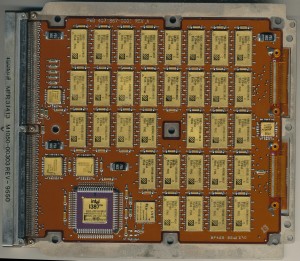
Essentially a complete 80386 system, of similar performance to a higher end system int he late 1980’s. Just with a lot more gold, and built to take a lot more abuse then your average beige box of the 80’s






